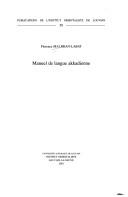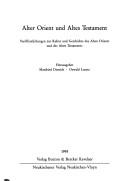| Listing 1 - 10 of 11 | << page >> |
Sort by
|
Book
ISSN: 05547342 ISBN: 9783447100939 3447100931 Year: 2014 Volume: 23 Publisher: Wiesbaden: Harrassowitz,
Abstract | Keywords | Export | Availability | Bookmark
 Loading...
Loading...Choose an application
- Reference Manager
- EndNote
- RefWorks (Direct export to RefWorks)
Akkadian language --- Grammar --- Akkadian language - Grammar
Book
ISSN: 05547342 ISBN: 9783447064569 3447064560 Year: 2011 Volume: 23 Publisher: Wiesbaden: Harrassowitz,
Abstract | Keywords | Export | Availability | Bookmark
 Loading...
Loading...Choose an application
- Reference Manager
- EndNote
- RefWorks (Direct export to RefWorks)
Akkadian language --- Akkadien (Langue) --- Grammar. --- Grammaire --- Grammar --- Akkadian language - Grammar
Book
ISBN: 9789004340961 9004340963 9789004472846 9004472843 Year: 2017 Volume: 118 Publisher: Leiden;Boston Brill
Abstract | Keywords | Export | Availability | Bookmark
 Loading...
Loading...Choose an application
- Reference Manager
- EndNote
- RefWorks (Direct export to RefWorks)
A Grammar of Old Assyrian describes the language contained in a very large corpus of cuneiform tablets mainly found in Anatolia in the middle of Turkey and dating to ca 1900-1700 BC. These tablets come from the archives of a community of Assyrian merchants who conducted a long-distance trade between Assyria and Anatolia and eventually settled in Anatolia. Alongside Babylonian, Assyrian is one of the main branches of Akkadian, the Semitic language spoken in Mesopotamia (roughly present-day Iraq) in the third, second and first millennium BC, and Old Assyrian is its oldest attested stage. Old Assyrian is also one of the oldest and largest corpora of texts in any Semitic language.
Akkadian language --- Grammar. --- Grammar --- Akkadien (Langue) --- Grammaire --- Akkadian language - Grammar
Book
ISSN: 21934436 ISBN: 9783447109796 3447109793 Year: 2018 Volume: 8 Publisher: Wiesbaden: Harrassowitz,
Abstract | Keywords | Export | Availability | Bookmark
 Loading...
Loading...Choose an application
- Reference Manager
- EndNote
- RefWorks (Direct export to RefWorks)
The Middle Assyrian period (ca. 1500-1000 BCE) is characterized by the transformation of the former city state of Ashur into an expansive empire. Over the last couple of decennia, the text corpus has grown considerably due to many archaeological excavations of archives in Syria. This grammatical description of Middle Assyrian seeks to improve our knowledge of the language of these texts. It takes into account recently published texts, including the archives from Tell Aš-Šēḫ Ḥamad, Tell Ḫuwīra, Tell Ṣabī Abyaḍ and Tell Ṭābān. The result serves as a long overdue supplementation to Mayer's "Untersuchungen zur Grammatik des Mittelassyrischen" (1971). The monograph consists of an introduction to the corpus and its historical context, followed by discussions on orthography, phonology, morphology and syntax. Non-Assyrian influences on orthography and grammar are also subject of discussion. In addition, comparisons are made between the different stages of the Assyrian language in order to put Middle Assyrian into context of its intermediate stage between Old Assyrian (ca. 1900-1700) and Neo-Assyrian (ca. 1000-600). Thus, the monograph is aimed at Assyriologists as well as Semitists
Akkadien (langue) --- Grammaire. --- Akkadian language --- Grammar --- Akkadian language - Grammar
Book
ISBN: 9514590465 9789514590467 Year: 2000 Volume: v.13 Publisher: Helsinki: Neo-Assyrian Text Corpus Project,
Abstract | Keywords | Export | Availability | Bookmark
 Loading...
Loading...Choose an application
- Reference Manager
- EndNote
- RefWorks (Direct export to RefWorks)
Akkadian language --- Akkadien (Langue) --- Grammar --- Grammaire --- Dialects. --- Dialectes --- Dialects --- Akkadian language - Grammar
Book
ISBN: 1575067161 9781575067162 9781575063065 1575063069 Year: 2014 Publisher: Winona Lake, Indiana: Eisenbrauns,
Abstract | Keywords | Export | Availability | Bookmark
 Loading...
Loading...Choose an application
- Reference Manager
- EndNote
- RefWorks (Direct export to RefWorks)
Students of Akkadian will find this handy collection of basic information to be the ideal companion through their years of study. Though this handbook is not a replacement for the standard reference works, it summarizes all the basic resource materials needed for the study of Akkadian. Included are the following: miscellaneous helps, paradigms of nouns and verbs, a glossary of important proper nouns, an index of logograms, a sign list with complete sign values, and much more.
Akkadian language --- Accadian language --- Assyrian language --- Assyro-Babylonian language --- Babylonian language --- Semitic languages --- Grammar. --- Spoken Akkadian. --- Grammar --- Spoken Akkadian --- Akkadian language - Grammar --- Akkadian language - Spoken Akkadian --- Akkadian language - Grammar - Handbooks, manuals --- Język akadyjski --- gramatyka.
Book
ISBN: 9514590597 9789514590597 Year: 2004 Volume: 16 Publisher: Helsinki : Neo-Assyrian Text Corpus Project,
Abstract | Keywords | Export | Availability | Bookmark
 Loading...
Loading...Choose an application
- Reference Manager
- EndNote
- RefWorks (Direct export to RefWorks)
Variation is a prerequisite of change ...without synchronic variation, change would not have a launching pad.” Thus says Raimo Anttila in his Historical and Comparative Linguistics. The problem with ancient languages is that it is difficult to get enough texts to be able to document variation. In this respect, the Neo-Assyrian period stands apart from most of the other eras of the Ancient Near East. The century after the coming to power of the Sargonid kings in 722 BCE is documented by thousands of preserved letters between bureaucrats of the royal administration written in the Neo-Assyrian dialect/language. The value of this letter corpus for being able to document synchronic variation in Neo-Assyrian is difficult to overstate. And this is in addition to the wide range of other types of texts available from this period.On the basis of this extensive corpus, it is possible to define variation in great detail across the grammatical spectrum: in graphotactics, in phonology, in morphology, in syntax, and in semantics. Thousands of detailed examples make the extent of synchronic variation in Neo-Assyrian explicit in a way that would not be possible without such wide-ranging documentation. Two detailed appendices on the letter corpus itself and on the senders of the letters would make useful handbooks on their own. And the discussed terms and the cited passages are fully indexed.

ISSN: 00761265 ISBN: 904290982X 2877235564 9782877235563 9789042909823 Year: 2001 Volume: 50 Publisher: Louvain-la-Neuve: UCL. Institut orientaliste,
Abstract | Keywords | Export | Availability | Bookmark
 Loading...
Loading...Choose an application
- Reference Manager
- EndNote
- RefWorks (Direct export to RefWorks)
Akkadien --- Akkadisch --- Linguistique --- Taalkunde --- Akkadian language --- Akkadien (Langue) --- Grammar. --- Grammaire --- -Academic collection --- Accadian language --- Assyrian language --- Assyro-Babylonian language --- Babylonian language --- Semitic languages --- Grammar --- Epigraphy --- Academic collection --- Akkadian language - Grammar. --- Akkadien (langue)
Book
ISSN: 00669903 ISBN: 0918986478 9780918986474 Year: 1987 Volume: 22 Publisher: Chicago (Ill.) : University of Chicago. Oriental institute,
Abstract | Keywords | Export | Availability | Bookmark
 Loading...
Loading...Choose an application
- Reference Manager
- EndNote
- RefWorks (Direct export to RefWorks)
Akkadian language --- Assyro-Babylonian letters --- Akkadian letters --- Assyro-Babylonian literature --- Accadian language --- Assyrian language --- Assyro-Babylonian language --- Babylonian language --- Semitic languages --- Grammar, Historical --- Texts --- Assyro-Babylonian letters. --- Grammar, Historical. --- Texts. --- Akkadian language - Texts --- Akkadian language - Grammar, Historical

ISBN: 3766699792 3788715367 9783766699794 Year: 1995 Volume: 242 Publisher: Kevelaer: Butzon und Bercker,
Abstract | Keywords | Export | Availability | Bookmark
 Loading...
Loading...Choose an application
- Reference Manager
- EndNote
- RefWorks (Direct export to RefWorks)
Bel-ibni, --- Correspondence --- Correspondance --- Babylonia --- Babylonie --- History --- Sources --- Histoire --- Assyro-Babylonian letters. --- Akkadian language --- Grammar. --- Assyro-Babylonian letters --- Akkadian letters --- Assyro-Babylonian literature --- Bel-ibni --- Bēl-ibni, --- Correspondence. --- Grammar --- Assyria --- Assur (Kingdom) --- Asshur (Kingdom) --- Politics and government. --- Akkadian language - Grammar.
| Listing 1 - 10 of 11 | << page >> |
Sort by
|

 Search
Search Feedback
Feedback About UniCat
About UniCat  Help
Help News
News